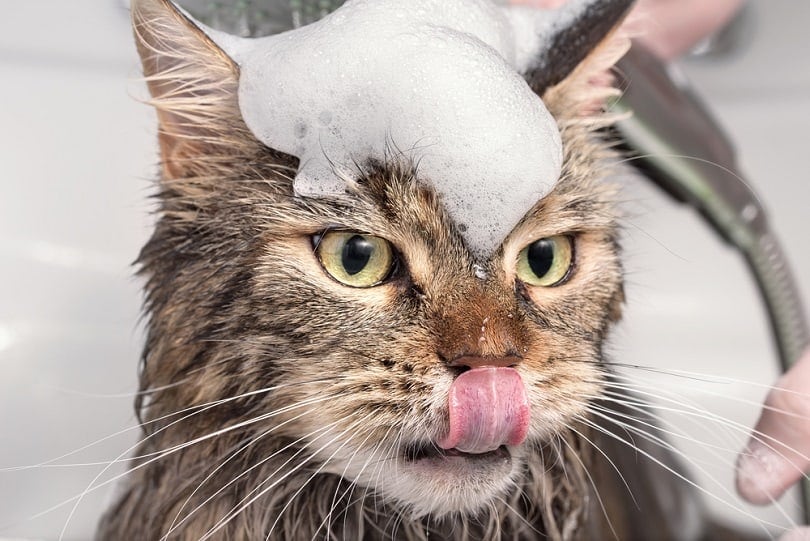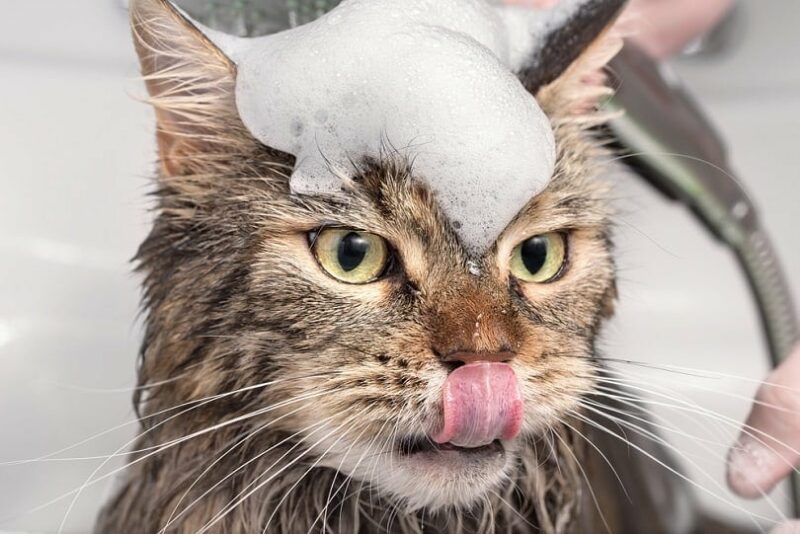As a cat owner, you usually don’t need to worry about giving your cat a bath all that often. But sometimes it’s necessary—perhaps your cat isn’t able to groom herself, or she’s gotten into something particularly nasty that she probably shouldn’t be licking off. This is where the necessary evil of bathing your cat will come in.
So, now you’re considering your options as to what kind of shampoo you would like to use. Maybe you have budgetary concerns, or you prefer a product that is made with natural ingredients—sometimes it’s nice to know exactly what is in the shampoo. Well, we’re to help with these 5 homemade recipes for your very own DIY cat shampoo.
The 5 DIY Cat Shampoo Homemade Recipes
1. Basic Shampoo
Basic Shampoo
Equipment
- 1 Bottle/ Container
Materials
- 4 cups of warm water
- 1 cup of apple cider vinegar
- 1 cup of Dawn dish soap
Instructions
- Very carefully mix the ingredients together (the Dawn will foam up if you shake too vigorously)
- add it to a clean bottle or container.
- Wet your cat with warm water and pour the mixture on your cat and rub it into her fur, ensuring it reaches the skin, and rinse thoroughly.
Notes
2. Moisturizing Shampoo
This moisturizing shampoo is suitable for cats with sensitive and dry skin. Particularly with the addition of the vegetable glycerin, which is a liquid that is usually made from palm, soybean, or coconut oils. You can replace the glycerin with Dawn dish soap, but the glycerin adds an extra moisturizing component to the shampoo, which will help any cats with dry skin.
- 4 cups of warm water
- ⅓ cup of vegetable glycerin
- ⅓ cup of apple cider vinegar
Mix the ingredients together in a bottle or container. Follow the same procedure as the first shampoo on our list. Get your cat wet with warm water, rub your shampoo into her fur and on her skin, and rinse well. Take some time with the rinsing because of the vegetable glycerin.
3. Sensitive Skin
This is a gentle shampoo that should work well for cats with sensitive skin. The oatmeal and baking soda will help to moisturize dry skin and will make the fur soft.
- 4 cups of warm water
- 1 cup of baking soda
- 1 cup of oatmeal (organic is best)
- 1 teaspoon of Dawn dish soap
The oatmeal should be ground up until it is as close to powder form as you can get. Place the ingredients into a clean container with a lid and shake well. After wetting your cat down, apply the shampoo and rub it into their fur, reaching the skin, and rinse well.
- Only Natural Pet Shampoo - Our vegan, plant-based formulation is made with safe and natural...
- No Soap - A cat and dog wash free from soaps, glutens, dyes, DEA, sulfates and phthalates means it's...
- Colloidal Oatmeal - Formula soothes and nourishes dry, irritated skin, providing itchy skin relief...
There are lots of pet shampoos to choose from, but some are much better than others. We love these two options by Hepper made with all-natural ingredients that gently clean your pet's skin and coat. These pH-balanced formulas contains moisturizing aloe vera and colloidal oatmeal, and it's free of dyes, phthalates, sulfates, and other irritants.
At Catster, we’ve admired Hepper for many years and decided to take a controlling ownership interest so that we could benefit from the outstanding designs of this cool cat company!
4. Dry Shampoo for Dry Skin
While we humans use dry shampoo on occasion, it is typically made with cornstarch and alcohol. For cats, you can use oatmeal that you warm up in the oven, which will work nicely if your cat has dry and sensitive skin.
Start by grinding up the oatmeal so it’s not as chunky, and warm it in the oven for 5 minutes on low heat—250ºF.
Before you put it on your cat, be sure to brush her fur thoroughly to ensure there are no mats or knots. Do this outside, on your porch, or in a room that you can sweep up easily.
Rub it into her fur and try to let it sit for about 5 minutes and then brush it out. The obvious advantage to this method is no water, but the disadvantage is the mess and expecting your cat to sit still for so long.
5. Dry Shampoo for Odor
Cats don’t tend to be smelly, but if your moggie gets into something stinky or if she’s older and has some trouble with grooming, you might just want a dry shampoo to absorb bad odors.
For this, you only need baking soda. Just like with the oatmeal, warm it up on a baking tray for about 5 minutes on very low heat, no more than 250ºF.
Also, like the oatmeal, you’ll want to do this outside or in a place that can be easily cleaned and will also contain your cat. Use the same method above. Rub it in, let it sit for about 5 minutes, and brush it out.

A Few Notes
It needs to be said that you should never use shampoo meant for humans on your cat. Humans and cats have very different pH levels, and our shampoo will dry out your cat’s skin.
- Petrochemicals
- Parabens
- Sodium lauryl sulfate
- Artificial dyes or fragrances
Be sure to avoid getting any shampoo in your cat’s eyes. This can cause irritation and pain.
Additionally, do not add any essential oils to your cat’s shampoo. Not only is it extremely harmful if your cat swallows any, but she can also absorb it through her skin or ingest it through licking her fur. Essential oils can poison your cat (some even through just inhaling) and lead to liver failure, seizures, and death.
Alternatives
If you’re in a rush to give your cat a bath (she’s a stinky, gooey mess) and you don’t have these ingredients or any cat shampoo handy, there are a few other alternatives you can use.
- Dawn dish soap: This soap is famous for its use in cleaning wildlife that has been coated in oil from oil spills. It’s an effective detergent that will gently clean any greasy messes your cat may have gotten into. However, this soap will dry out your cat’s skin if used frequently, so it should only be used in emergency situations.
- Baby shampoo: This shampoo is designed to be much gentler for babies, so it could also work on your cat’s delicate skin. A small amount on occasion won’t damage your cat’s skin.
- Castile soap: This soap is made with olive oil and is very gentle and moisturizing. Just be sure that it doesn’t have any added ingredients and is 100% pure.
Any of these are safe for you to use on your cat in an emergency bath situation, but it’s best to not use them regularly.
Additional Information:

Conclusion
In the long run, it would be best if you purchased cat shampoo that is gentle and doesn’t contain any added harsh chemicals or fragrances. Since cats don’t usually need a bath very often, one bottle should last you for quite some time. But if you do need to give your cat a bath and you find yourself literally in a sticky situation without any car-safe shampoo, we hope that one of these DIY shampoos will help and that you and your cat come out of the bath unscathed.
You might also like:
- How to Stop Your Cat from Over-Grooming: 9 Proven Methods
- 9 Best Cat Grooming Gloves of 2024 – Reviews & Top Picks
Featured Image Credit: Olleg, Shutterstock














